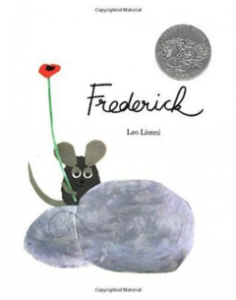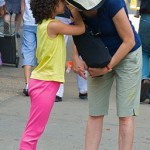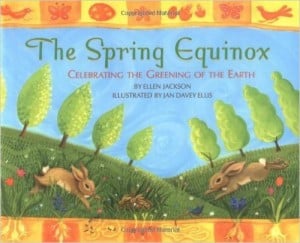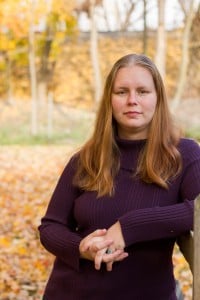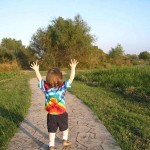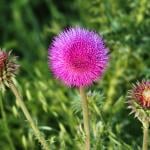By Meg Yardley
The Celtic festival of Imbolc, also sometimes called Brigid after the goddess who is celebrated at this time, is a wonderful festival to celebrate with children, as it focuses on the hearth and home. Depending on where you live, Imbolc may or may not seem like the “beginning of spring” as it is often described. Historically, this is a time of year when people have often been desperately in need of hope, as food stores dwindle and the earth is not yet producing new plants and crops. Even those of us lucky enough to live with a more stable food supply can feel that the days are beginning to get longer and hope for the coming of spring.
Traditional activities of ritual and celebration include cleaning and blessing the house; blessing any new ritual items or any other special new household objects; eating dairy foods and honoring the animals they come from; and making candles. Here are some suggestions for Imbolc activities to do with children.
In honor of Imbolc, you may also want to seek out books related to:
- The goddess Brigid (also spelled Brighid, Brid, Bride) – There aren’t any picture books about Brigid that I have found, and to be honest I haven’t had much luck with Celtic myth/ fairy tale collections either, but maybe your search will be more fruitful than mine was. There’s a lovely contemporary Brigid story (with black-and-white illustrations) in Circle Round by Starhawk, Anne Hill, and Diane Baker.
- Crafts and crafting – Any books that celebrate creative works are good at this time of year.
- Poetry – Brigid is traditionally a goddess of poetry. A couple of nature-related children’s poetry collections I have enjoyed are Sharing the Seasons, a book of seasonal poetry collected by Lee Bennett Hopkins, with lovely illustrations by David Diaz; and the bilingual book Del Ombligo de la Luna/ From the Bellybutton of the Moon by Francisco X. Alarcon (also with beautiful illustrations by Maya Christina Gonzalez).
- Sheep and lambs – Some etymologies say that Imbolc comes from oimelc, “ewe’s milk,” while others say it comes from imbolg, “in the belly,” i.e. pregnant ewes. So celebrating sheep and lambs is in line with the festival’s history. For toddlers, there are many board books about cute little lambs; for older children, I love the 1970’s photo-illustrated story The Little Lamb, by Phoebe Dunn.
While all the other mice are hard at work storing up food for the winter, Frederick seems to be doing nothing at all. Yet once all the mice are indoors, trying to make it through the long winter, they find out what he has really been doing: storing up images, colors, words, and the warmth of the sun to get everyone through the hard winter time. This classic tale by Leo Lionni is a wonderful one for the late winter when everyone has cabin fever and is tired of being indoors; it celebrates the ways the imagination can bring the world alive. For older toddlers and up.
Pagan Notes: Frederick’s use of words, images, and visualization to make everyone re-experience colors and feelings is deeply magical. This book celebrates the dreamers and artists who bring our communities alive and move us beyond simple survival. (Frederick also recites a sweet little poem about four mice who are the four seasons of the year.)
The Story Blanket, by Ferida Wolff and Harriet May Savitz 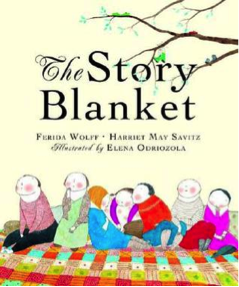
In this Eastern-European-flavored tale, Babba Zarrah tells tales to children while they sit on her story blanket. But one winter, when the village has run out of yarn, she begins to unravel pieces of the story blanket to knit warm clothing for those who need it. As the story blanket gets smaller and smaller, the other villagers find a way to return the favor. For preschoolers and up.
Pagan Notes: This is a lovely story about community and how we give to one another in times of need. To me, it speaks of Imbolc’s themes of creativity, warmth, and community togetherness in the midst of winter.
Sweet Clara and the Freedom Quilt, by Deborah Hopkinson
 Are you ready to talk with your child about slavery? You may not feel ready – can anyone ever really be ready to explain evil to children? – but this book could be a good starting place. (Here are some guidelines for teaching children about this topic.) As young seamstress Clara starts to think about escaping to freedom, she pieces together information about places and roads in the outside world, and with this knowledge she pieces together scraps of fabric into a pictorial map of the route to freedom. In the end Clara successfully escapes and rescues her mother, leaving the quilt “map” behind for others to use. This book offers beautiful illustrations, solid character development, and an intriguing premise. Other than one mention of “beating,” there is no depiction of brutality or overt violence. Recommended for ages 5 and up.
Are you ready to talk with your child about slavery? You may not feel ready – can anyone ever really be ready to explain evil to children? – but this book could be a good starting place. (Here are some guidelines for teaching children about this topic.) As young seamstress Clara starts to think about escaping to freedom, she pieces together information about places and roads in the outside world, and with this knowledge she pieces together scraps of fabric into a pictorial map of the route to freedom. In the end Clara successfully escapes and rescues her mother, leaving the quilt “map” behind for others to use. This book offers beautiful illustrations, solid character development, and an intriguing premise. Other than one mention of “beating,” there is no depiction of brutality or overt violence. Recommended for ages 5 and up.
Pagan Notes: Many contemporary Pagans (especially in the Reclaiming tradition) envision Brigid as a goddess who lends her fire and her creativity to activism and social change movements. Learning about the terrible wrongs of the past is an important part of learning how to make things right in the future. Clara is a strong, imaginative character who makes a difference, not only for herself, but for others who will come after her. In addition, the book shows arts and crafts being used in the service of justice and freedom.
“Skysisters,” by Jan Bourdeau Waboose 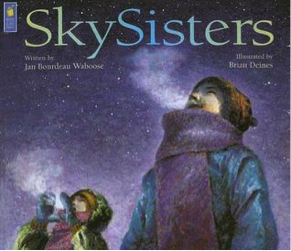
Two Ojibway sisters take a night-time walk through the deep snow to look for the Sky Spirits (the northern lights). The story is paced gently and some children may find the action a little slow, but my child liked the portrayal of the relationship between the sisters as they discover many beautiful things in the wintry night. For preschoolers and up.
Pagan Notes: Without much explicit religious or spiritual discussion, this story portrays how nature-based spirituality is part of a family’s daily life. I appreciated that the story has a spiritual aspect but the relationship between the sisters is very real-life (they tease and bother each other). While some of the other books on this list focus on celebrating light and warmth and holding fast to the idea that spring will come, this book is really all about honoring winter and darkness themselves, and finding the beauty in winter.
“A Child’s Book of Blessings,” by Sabrina Dearborn
(Note: Newer editions of this are called “A Barefoot Book of Blessings” but the content is the same)
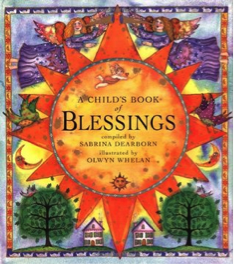 A collection of short prayers and blessings from a variety of religious traditions. My child appreciated the lush, richly detailed illustrations as a toddler, before having the attention span to truly listen to the words. (I know tunes for a few of these blessings and would sing them as we read the book.) As an older toddler, my child requested to read the book and would sometimes recite lines from the blessings around the house (“Peace from my heart to your heart”). The book has also provided a great entry-point into discussing different religious traditions. I wished at times the attributions were more specific (and not just “Christian” or “African”).
A collection of short prayers and blessings from a variety of religious traditions. My child appreciated the lush, richly detailed illustrations as a toddler, before having the attention span to truly listen to the words. (I know tunes for a few of these blessings and would sing them as we read the book.) As an older toddler, my child requested to read the book and would sometimes recite lines from the blessings around the house (“Peace from my heart to your heart”). The book has also provided a great entry-point into discussing different religious traditions. I wished at times the attributions were more specific (and not just “Christian” or “African”).
Pagan Notes: Among the variety of traditions represented, this book includes specifically (neo-) Pagan blessings and prayers, which I find is rare in children’s books on spirituality. It felt very validating to me as a way to share these traditions with my child. There is a nice candle blessing in this book which would work well for this holiday, and in general, Imbolc is a wonderful time to enjoy poems, songs, stories, and prayers with our children.
 “Purple, Green, and Yellow” by Robert Munsch
“Purple, Green, and Yellow” by Robert Munsch
In this whimsical, light-hearted story, a girl named Brigid keeps begging her mother for fancier markers until finally she gets the “super-indelible-never-come-off-till-you’re-dead-and-maybe-even-later” coloring markers she really wants! She promised her mother she would not color on her own body with the markers, but when (of course) she does, she and her mother will have to come up with some magically creative solutions. I love that this story is based in child logic. (For instance, to a parent, a washable marker is the best kind… to a child, not so much.) But beware: reading this book will almost certainly inspire your child to color on themselves. For preschoolers and up.
Pagan Notes: My friend Vicki recommended this book to me, saying her coven always used to read this to their children (now grown up!) to celebrate Imbolc. When I read it, I could see why: A child named Brigid… The magical power of imagination… The transformative nature of the arts… Sounds just right!
“Brigid’s Cloak,” by Bryce Milligan
This book begins with Saint Brigid’s birth, when a Druid brings her a special blue cloak, and then recounts how (as a child) she travels back through time to assist at the birth of baby Jesus. I found the time travel a little disjointed and confusing. Otherwise, it is a sweet story and has some lovely descriptions (the stars singing at Brigid’s birth; Brigid felt “as one does when a candle is lit in a dark room”). The illustrations are truly gorgeous; young Brigid has a gentle and open face, the colors are vivid and bring to mind medieval illuminations, and each page is bordered with intricate Celtic knotwork. For older preschoolers and up. 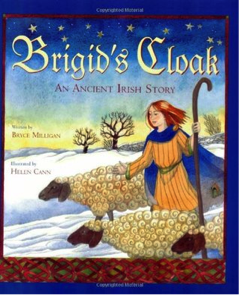
Pagan Notes: This book will disappoint you if you’re looking for a story about the goddess Brigid or even about the more pagan aspects of Saint Brigid of Kildare (much of whose worship has historically blended with traditions of the goddess). This is a Christian story centering around the birth of Jesus. The portrayal of the Druid is mostly positive, including a beautiful drawing of him with oak leaves in his hair bringing a blessing for Brigid. At the same time, he brings the message that Brigid will be one of the mothers of “the new Ireland,” i.e. Christian Ireland. I hesitated about whether this book belongs on this list, but it may be a good choice if you want your child to read a Celtic Christian story which honors Paganism as a historical reality. It also does offer some images of Saint Brigid, even if they are not the ones that most overlap with goddess images. I explained it to my child (who loved the book) this way: “You know Brigid was a goddess in Ireland, but this book is about a girl named Brigid who was also a special holy person in Ireland. So even though she is not the same as the goddess Brigid, she is a lot like the goddess.”
Meg Yardley is a Pagan and a parent of two young children, living in the San Francisco Bay Area. She sings with the Turning Earth Singers, a Pagan music ensemble which recently led a “Pagan Kids’ Song and Story Time” workshop. She appreciates pictures books as a wonderful spiritual practice parents and young children can share.
Editor’s Note: You can find books reviewed at Pagan Families in our Amazon store.

